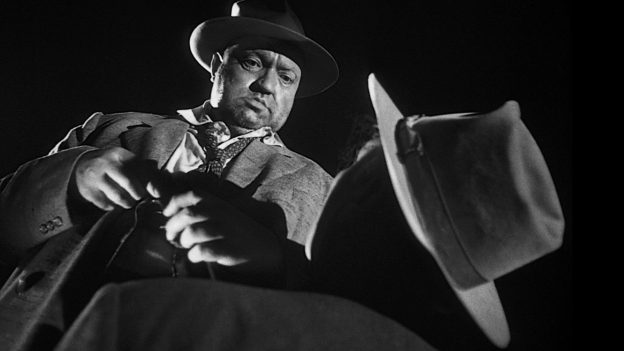Yasaman Rafiei, July 24
Touch of evil is about the unlimited decline of the human nature. The plot is suspenseful, well written, with good pace. The movie is about the battle between an American policeman (Hank Quinlan) and a Mexican policeman (Ramon Miguel Vargas), who are symbolic representatives of their countries.
The opening scene of the movie (tracking the bomb) is dramatic. I enjoyed the suspense in which I knew the bomb is going to go off but without knowing what and who is going to be hurt and why?
The music reminded me of the music in Tarantino’s movies that induces a different sensation from the scene itself (romantic music on violent scenes). In Touch of Evil, the Latino and Jazz music throw me off balance and for me was a bit distracting (e.g. the hotel scene, where they wanted to inject heroin into Susie).
In this film, Femininity is arguable as it is defined as a symbol of desire. Women in a hyper-sexualized way are mere sex objects; this includes Susie (Miguel’s wife) and all other women of the movie, who are mostly sex workers and play passive roles with weak minds. Touch of evil, like many other Hollywood films, objectifies women and claims that the only reason for their existence is to please men. The depict of a weak woman is tangible in the scene in which Susan wants to go back to Us. She crosses the border to Mexico and her first impression of the new country is that Mexico is not safe; thus, she requests to go back to a hotel in the US border to be “safer”. Vargas as a Mexican tried to prove the true face of his country and he emphasises that “you know this is not a true Mexico”. Vargas believes that the image which is shown from Mexico in the border of United States is the false representation of his country. Susan after seeing the chaos on the border wanted to go back to her country, but she easily changed her mind when she got a letter from Pancho. The sexual attractions of Mexico seduced her to stay.
Another important theme of this movie besides decline of human nature is the matter of identity. The very first sign of identity and changing the identity is when at the border, the officer asked Susan “what is your surname?” she said her paternal family name and then Miguel (her husband) emphasised his Mexican surname (Vargas); this moment is important in two aspects. Firstly, in terms of gender and the dominant masculinity that shapes the woman’s identity, the personality of Susan in the entire movie is framed as Vargas’s wife. Secondly, in terms of nationality, he tries to impose his Mexican origin over hers, as an effort to familiarize her with his country, culture and origin.
On the other hand, Hank as a symbol of the United States is trying to prove that Mexicans are the cause of all chaos and sabotage on the border. While the only way for Vargas as a Mexican to deal with these lies is through consistent resistance and struggle. He tries hard to prove himself and his words. When Miguel Vargas understood that the American policeman pretends that he has found a dynamite in a box, nobody believed him and the American police accused him of covering up for the Mexican delinquent. In the story, the Americans are not being investigated as much as the Mexicans; moreover, the two policemen don’t have the same level of influence on the issue. The process is such that the Mexican part is to blame unless otherwise is proven with a valid certificate, such as a voice recording. In Touch of Evil, the colonized side, which is symbolized by Miguel, could conquer the colonial power (i.e. Hank) by resisting and challenging him and looking at him as the colonist.
Finally, what I really enjoy about this movie is its characters, especially the ambivalence character of Captain Hank Quinlan, played by Orson Welles, who demonstrated his acting skills as a hero and a villain. The general ambient of the movie is dark, gloomy, and melancholy; but, the drama benefitted from this. The events continued in their dark aura until the climax of the movie was reached with the karmic cliché and moral conclusion that the world will get back at those who do evil.

Hi Jas, I agree with your analysis of the role of Susan in the movie. She exists only as part of Miguel Vargas. Its through her that the Grandis and Hank Quinlan will get back at Miguel Vargas. She is like a prop, malleable to suit the needs of the scene, even invisible if necessary. Miguel, for example, drives past her as she screams from the balcony of the seedy hotel without seeing her.